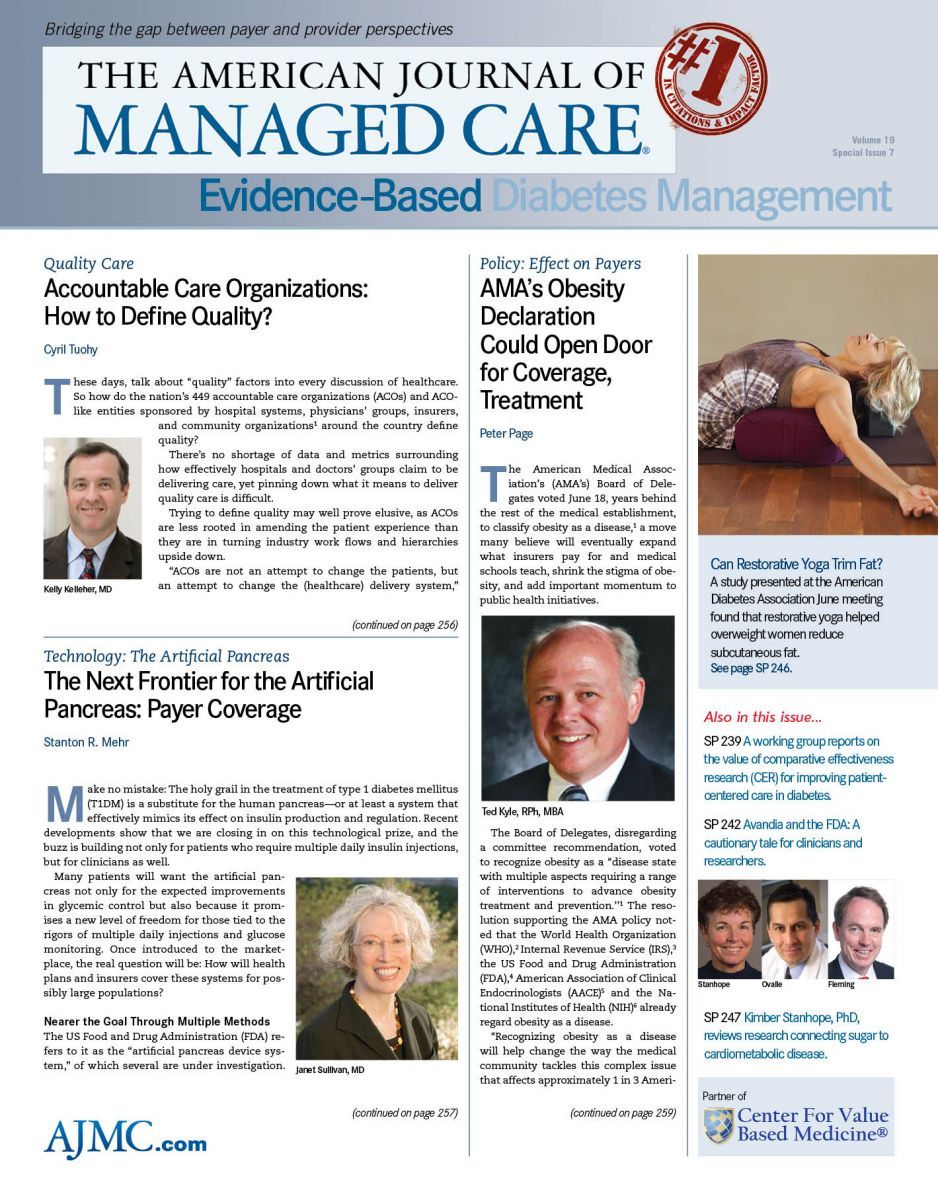- Center on Health Equity & Access
- Clinical
- Health Care Cost
- Health Care Delivery
- Insurance
- Policy
- Technology
- Value-Based Care
Restorative Yoga Better Than Stretching for Trimming Subcutaneous Fat in Overweight Women
Coverage from the 73rd Scientific Sessions of the American Diabetes Association.
Almost any doctor would tell an overweight patient—especially one who gets little activity—to start exercising. But for the obese, those with a body mass index (BMI) of 30 kg/m2 or higher, just getting started can be daunting.
With that in mind, Maria G. Araneta, PhD, MPH, of the University of California, San Diego, designed a study to determine whether obese women would see a loss of fat from less intense exercise than aerobic activity, which is known to increase the heart rate and burn calories and fat. She presented results gathered with co-authors Matthew A. Allison, MD, MPH, Elizabeth Barrett-Connor, MD, and Alka M. Kanaya, MD, at the 73rd Scientific Sessions of the American Diabetes Association in Chicago (June 21-25).1
Smaller studies had shown other health benefits from yoga to persons at risk of diabetes,2 but Araneta said no study had specifically measured a loss of fat. Araneta and her colleagues wanted to know who would benefit more: women who took part in a 48-week program of restorative yoga, or those who engaged in a program of stretching exercises.
Their findings showed that the restorative yoga practitioners lost significantly more subcutaneous fat over the initial 6 months of the study period, and kept losing it during a maintenance period with less direct supervision. There was no significant loss of visceral fat in either group.
The difference between restorative yoga and other forms is key: Unlike more intense forms of the ancient practice, restorative yoga does not feature flowing body movements or challenging balance poses. As Araneta said, “The postures focus on relaxation and stress reduction and are more feasible for overweight individuals.”
While stretching and body alignment are involved, restorative poses are often performed in a reclined or seated position, with limbs and parts of the torso supported by blankets, pillows, or padded bolsters that resemble a sofa cushion. Poses are held much longer than in other styles of yoga, often as long as 7 minutes. Measured breathing is emphasized, and many commercial classes feature meditative music.
The yoga group (n = 88) had a mean age of 55 years, and an average BMI of 36 kg/m2. The stretch group (n = 83) had a mean age of 54 years, and an average BMI of 32.5 kg/m2. Despite this difference, Araneta said, there were not significant differences in weight and subcutaneous fat between the 2 groups at the start of the study. All participants had metabolic syndrome as defined by International Diabetes Foundation (IDF) criteria.
Study subjects received medical evaluations at 3-month intervals, with subcutaneous and visceral fat being measured between the L4 and L5 vertebrae with a 16-detector helical computer topography (CT) abdominal scanner. Participants received semi-weekly and then weekly classes in the first 12 weeks, then bi-weekly classes to the 6-month mark. The final weeks served as a “maintenance period,” when participants were asked to do their yoga poses or stretching exercises largely on their own, with classes only once a month.
Both groups lost weight, with the restorative yoga practitioners losing more, an average of 1.3 kg at 6 months compared with 0.7 kg for the stretch group. Significantly, the yoga group maintained the reduction, with the average weight loss reaching 1.7 kg at the 48-week mark, even when controlling for BMI.
The difference in subcutaneous fat loss between the groups was more pronounced, however. The restorative yoga group lost 31 square centimeters at 6 months, compared with 12 square centimeters for the stretch group. At 48 weeks, the yoga group had continued its loss to 34 square centimeters, while the stretch group was moving in the other direction, back to 6.6 square centimeters.
One explanation for the difference may be that restorative yoga reduces levels of cortisol, which rises during times of stress and is known to increase abdominal fat. Contacted in August, Araneta said her team is reviewing data on cortisol, and results will be released later in 2013.
In Chicago, Araneta did not present restorative yoga as a replacement for aerobic activity; rather, she said this “complementary, ancient practice” could serve as a means of gentle movement for those severely obese patients for whom other activity is not practical. The study was funded by the National Institutes of Health.
1. Araneta M, Allison MA, Barrett-Connor E, Kanaya AM. Overall and regional fat change: results from the Practice of Restorative Yoga or Stretching for Metabolic Syndrome (PRYSMS) study. Results presented at: 73rd Scientific Session of the American Diabetes Association; June 22, 2013; Chicago, IL.
2. Hagins M, States R, Selfe T, Innes K. Effectiveness of yoga for hypertension: systematic review and metanalysis. Evid Based Complement Alternat Med. 2013. 2013:649836
Photo Credit: RAVI BHATIA PHOTO/SessionsWithRAVI@gmail.com

What It Takes to Improve Guideline-Based Heart Failure Care With Ty J. Gluckman, MD
August 5th 2025Explore innovative strategies to enhance heart failure treatment through guideline-directed medical therapy, remote monitoring, and artificial intelligence–driven solutions for better patient outcomes.
Listen

